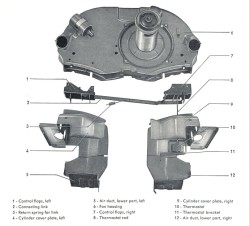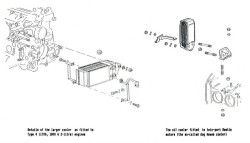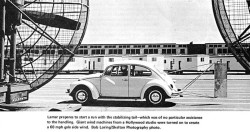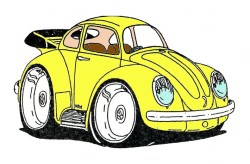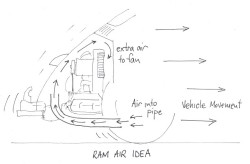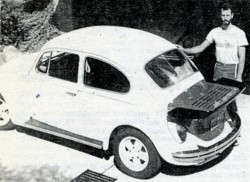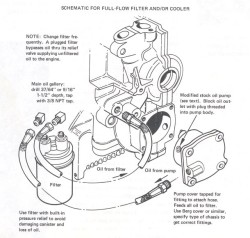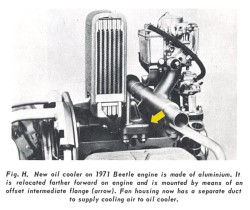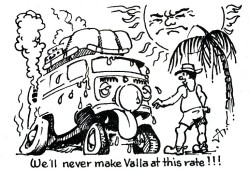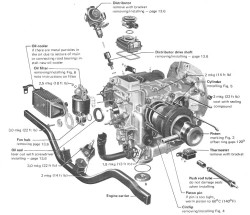Cooling
Thermostat and Flaps
Uprate Your Cooler
Whale Tales Part 1
Whale Tales Part 2
Whale Tales Part 3
Whale Tales Part 4
Extra cooling
Improved Cooling
Hot Kombis from the tropics
A Hot VW
Thermostat and Flaps
By Rod Young
October 1987
The system of thermostat and flaps on air-cooled VW motors is very often dismantled on motors in Australia, under the mistaken belief that they are not necessary in a country that doesn't have much ice and snow. In fact, they fulfil a very important purpose in allowing the engine to warm up quickly, thus improving drivability and fuel consumption and reducing engine wear. I get the feeling that the reason most thermostat bits end up in the bin is that engine rebuilders get sick of disassembling and assembling the numerous components, or else one or two get lost and the whole lot is scrapped. Holes are left in the fan housing by the removal of flaps, which doesn't help cooling matters either.
Another reason for the removal of these parts is perhaps that some people can't fully trust them to do their job. It is a mostly foolproof set-up in that if anything goes wrong, the return spring holds the flaps in their open (safe) position. But you can never really be sure, as you can't see at any time whether the flaps are open or shut.
My suggestion is that some mark be put onto the linkage so that its movement can be monitored. If ever you encountered overheating problems, it would be good to eliminate the flaps as one possible source. On Type 3 engines this job is easy - the operating rod is just visible at each end and all you have to do is grind a small mark on the top of the rod while the engine is cold. When the motor warms up, the rod will twist and you will be able to see the mark move.
On Beetle engines it is a little harder, as some parts need to be removed. The operating link in front of the fan housing that clips onto the flaps can be extended on the right-hand side by welding a short piece of metal to it. This extension is sized so that it moves out of sight when the thermostat heats up. On my engine I have welded a piece of steel 40mm by 10 mm to the operating link. For greater clarity it can be painted red. Then, if the engine is hot and you can see red, you know something is wrong. During engine assembly, adjust the thermostat exactly according to factory settings and check its operation by heating it up with a hot air gun or an oxy flame.
While on the subject of thermostat and flaps, on the big flat Kombi engines they are essential, as the flaps provide the airflow path to the oil cooler. If your Kombi has had its flaps removed (there is one well known engine builder which throws them away as a matter of course) you should do something about putting them back on, as your engine is much more prone to overheating.
Uprate Your Cooler
By Stephen Muller
March 1990
VW air-cooled engines rely on oil cooling far more than your average water-pumper. Oil cooling has been a fundamental part of the design since some of the first prototypes. The first oil coolers, up to the mid-‘50s, were soldered and had problems with leaking. Later designs were improved with a brazed design.
In 1961, at the advent of the Type 3, the first aluminium oil coolers were introduced. These were more expensive to produce, but had more surface area and were thus more effective. Moreover, they were bolted down horizontally, which was necessitated by the "flat" engine configuration of the Type 3.
Up until 1971, the steel oil cooler was still part of the Beetle engine layout. It was completely hidden inside the fan housing, and its exhaust air exited over the base of cylinders 3 and 4. Then, along with the introduction of strict emission controls in the US and hotter-running engines, the so-called ‘dog-house’ oil cooler was introduced. This was essentially the old Type 3 aluminium job, minus oil pressure switch, mounted on a sandwich block and located at the front (firewall side) of the fan housing. Its exhaust air exited through the front tinware, well away from the cylinders, just like Type 3.
The dog-house cooler is by far the best-designed cooling package available on upright engines. Along with it came a larger-capacity fan and larger oil galleries to get heat away from the heads better.
With the introduction of the Type 4 in 1968, VW produced a yet-larger aluminium oil cooler with two extra rows. This was only what you would expect for a larger, more powerful engine. This cooler was used right up till 1983 on 2-litre Kombi engines. This larger cooler, being a VW product, compatibility was held in high regard during its design, and it has the same mounting flange as the Type 1/Type 3 number. In other words, you can bolt it on!
One of the essential things, which must be done whenever displacement and power are increased on an engine, is to increase the cooling capacity in line with these changes. The normal route chosen is an external cooler, which may or may not be located in a good position for cooling, and more often than not has leaks. In fact, I dare say that most additional external oil cooler installations I have seen have made the engine run hotter than the excellent factory setup, due in part to the fact that many of the kits require removal of the stock cooler, which thoroughly upsets air flow inside the fan housing. Gene Berg has ascertained this through extensive testing. He found that air flow to the heads on all cylinders was reduced when the restriction to air flow offered by the stock cooler was no longer in play. This was because most of the air was being dumped over the base of cylinders 3 and 4, where it does little useful work.
There are other good reasons not to use an external oil cooler. They are expensive, easily damaged, often require cutting up panel work, and rubber oil hoses can crack and wear out, as well as blowing off under high pressure. This can be highly embarrassing sometimes.
There is a better, less messy, factory way of doing things, which is the whole point of this chapter. The Type 4 cooler can be adapted quite easily to fit both Types 1 and 3 engines. Of course, it is too wide to fit into the existing aperture, so some cutting and re-welding is required, but it's pretty easy stuff really.
When fitting this cooler to a Type 1, you must make sure that the top engine/gearbox mounting point has a captive nut installed, otherwise you'll need a severely distorted wrist to get in there to put that nut on, because the cooler sits nearly hard up against the firewall.
Be sure to fit the original or replacement foam back onto the front side of the cooler to ensure air sealing. Finally, it is most advisable to fit the thermostat and flaps. There is a slight clearance problem on the cross bar, so this will need to be modified carefully to fit.
In the case of the Type 3 engine, the studs holding the cooler on need to be lengthened about 15mm and the oil pressure switch needs to be relocated to the Beetle position. The top tinware can be squeezed over the top of the cooler, but the original foam rubber will have to be removed. It's better, therefore, to remove the tin, cut and weld to make more space, then re-fit.
Your engine doesn't need to be modified to take advantage of this mod. You can give your stock engine more cooling reserve and have extra peace of mind. This applies particularly to 1600 Kombis in a hot climate.
A warning. When you go looking for your wider cooler, buy a new one or have your old one ultra-sonically cleaned (this is the only way you should contemplate cleaning a cooler). You wouldn't believe what sludge can be lurking inside a used cooler, and how can you be sure that the engine hasn't chewed a bearing and distributed all the tiny bits through the oil circuit? One of the most common causes of new high-performance engines failing within a short time is the utilisation of second-hand coolers.
Finally, Types 1 and 3 engines aren't the only possible recipients for this cooler. Before Golf GTIs started using a water-cooled oil cooler, they used...a Beetle oil cooler behind the grille. Replacement with a Type 4 cooler is a most straightforward job. That's a tip that even most water-cooled buffs aren't aware of, as you would need to have a foot in both camps to be aware of it.
Whale Tales Part 1
By Steve Carter
August 1990
Phil Lander and I sometimes go to swap meets in some weird places in search of that Hazet tool box or Okrasa engine; needless to say, I'm still looking.
The last swap meet we went to was at Bomaderry a few weeks ago, and I found an old book ‘How to Hot Rod VW Engines’, by Bill Fisher (1970). I used to have this book years ago and I read it then with fascination trying to find cheap ways of modifying my 40HP Beetle on apprentice wages.
One section of the book is dedicated to curing VW handling problems. The author, among other things, knocks VWs for their high roll centre at the rear, high centre of gravity, swing axles, ineffective shocks, flexible soft suspension, narrow tyres and skinny rims (seems to me people who drive Yank Tanks shouldn't throw crossplies!)
The author also implied that the VW wheelbase is a problem, (too short?); I don't think so, because a VW has a longer wheelbase than a Porsche - even the late 911S.
The thing that cheesed me off later in life was his poo-pooing of the use of aerodynamic aids; I can tell from practical experience how much the Powertune fibreglass spoilers have helped my own Beetle. Firstly, in the dim old days when I had a fairly standard motor car, a friend had a nearly identical Beetle to mine, his a '71 Superbug, mine a '72. His motor had a Holley Bug Spray fitted, mine only had the standard Solex. As would be expected at our regular traffic light derby, he would blow me off severely, but after I had fitted the front air dam, my Beetle became much more slippery at high speeds, insomuch as, where before I could not get near him on the open road, I was now able to pass him as if I had an extra 10hp. I later fitted a mild 1640 engine with a Holley Bug Spray and was easily able to achieve 42mpg.
So I think this man was having his readers on. In my time working at Powertune, I had the good fortune to help Greg Mackie with his red Beetle sports sedan. After some coaching from Adrian Corvisy, Greg fitted a whale tail, and was quite impressed with extra stability going over the hill before the loop at Amaroo Park. Greg actually fitted an extra, clear perspex lip to further improve the downthrust. I have the same tail fitted to my own Beetle, and can only rave about the improvement to the handling.
Whale Tales Part 2
By Rod Young
September 1990
We have already discussed the aerodynamic benefits of fitting a so-called whale tail to a Beetle. I have had a whale tail fitted for about nine years and have always taken for granted the effects that Steve was telling us about, without ever having made any trials for myself (back-to-back runs at illegal speeds on the expressway being the way I would have done it, if I'd thought about it). So thanks, Steve, for presenting some hard evidence.
The effect that I've always been aware of since having a whale tail fitted, however, is on cooling. Mine has two large slots on the horizontal part where air can get in. At that time I had just fitted a VDO cylinder head temperature gauge, and noted an immediate reduction in temperatures after the whale tail went on. The previous engine lid I had fitted was a so-called duck-tail, which was like the standard engine-lid shape, but with a smaller protrusion. It also had extra air vents, so the base line for temperatures that I was comparing with was also probably improved somewhat over stock. So I deduced that, as far as cooling was concerned, the whale tail was a good thing.
In those days I had an 1835 based on a 1500 motor, complete with 1500 fan housing and upright standard oil cooler. I had also fitted a large and complex thermostatically controlled external oil cooler, which worked very well. All in all, oil temperatures were in what seemed to be the ‘right’ range - warming up fairly quickly and stabilising at around 80 degrees Celsius. Hard driving in summer would see about 90 degrees. I was happy with this.
Some time late I decided to rebuild the motor from scratch, using a brand-new crankcase and all the nice bits. A 1600 fan housing just had to be used, too. I knew that this would give me more cooling reserve and could only be beneficial.
As you're probably aware, the 1600 Beetle fan housing has a wider fan and a larger, offset aluminium cooler that vents to the outside air. It was introduced at the same time as US emission controls, to cope with the higher engine temperatures which came along with that.
For some reason I had trouble fitting the fan - I couldn't get the offset right so that it would clear the fan housing without rubbing - so I decided to belt the centre of it with a hammer, hoping to offset it slightly. This was a mistake, as a circular section snapped off entirely (the school of thought of ‘when in doubt, bash the shit out of it’ isn't always effective). So sadly, I went back to the 1500 fan.
In spite of the lower-output fan, the results were dramatic - much lower head temperatures were evident. This proves to me that the later fan housing is more efficient, as well as being more effective due to the wider fan.
I ran it that way for a while, but it was running ridiculously cool. After ascertaining that it was a case of over-cooling, rather than false indicating, I took the brave step of replacing the 1500 fan with one from a 36-hp motor. There was very little change in temperatures. Now, we're talking about an 1835 motor with a power pulley and a 36-hp fan, which still runs cold! Impossible-sounding, but true!
The aim of these details is to show that it was the whale tail that was responsible for the huge increase in cooling efficiency. To qualify that, I can't be absolutely sure, since I haven't gone about this in a scientific manner; I have made other changes which might have affected the cooling, haven't measured the effect of changes one at a time and haven't submitted to double-blind trials. But my objective wasn't solely to gain knowledge, but to improve the car. Nor am I about to start taping up holes with cardboard and go running around comparing temperatures.
So, I'm fairly sure that it was the whale tail that caused it all.
Just to give you some actual examples of how absurdly cool this thing runs: in normal city driving, head temperature is around 60-70 degrees (the head sensor is mounted on the fin over the inlet port - a cool spot, I know). On a recent drive up the expressway to Newcastle, ambient temperature 18 degrees, head temperature 75 degrees at the top of the big hill just up from the Hawkesbury River. Oil temperature also 75 degrees. When I got out of the car after the trip, I could put my hand over the cylinder tinware and hold it there as long as I liked! Enough said?
Why so cool? The air inlet to the Beetle's engine compartment is located at the rear of the car, out of the high-velocity air. Our friend Daniel Bernoulli (1700-1782) stated that high-velocity fluids are under reduced pressure. The lowest pressure is over the roof, where the air has to speed up to get over the curved surface. The air slows down again as it reaches the air inlets, and so the pressure rises, but never greater than atmospheric pressure.
Now, if you add a whale tail, the flow conditions at the rear of the car change. Air is forced to change direction over the horizontal surface of the whale tail, and where air is deflected in this way, the pressure in front of the obstruction is raised. Just in front of the trailing lip are air inlets. If the air pressure at the inlet is raised, more air flows through, keeping the engine running cooler.
By the way, to dress up the air inlet holes, I used aluminium accessory grille covers from the front of a Kombi.
My problem now is that I can't control the excessive cool-running situation. I'm sure that fuel consumption and engine wear would be reduced if I could.
I could just restrict the output of the fan by keeping the thermostat flaps partially closed, or engineer a big air leak, but I'm not satisfied with this - I want to still enjoy the safety margin of a large cooling reserve.
The standard thermostat is set to open at 70 degrees C, I think. Unlike on water-cooled engines, it does not regulate engine temperature for most running conditions, only during warm-up, and then it stays wide-open. If I could find one which opened at a higher temperature, I'd be happy. I've tried to fool it into thinking that the temperature was lower, so that it would stay closed longer. To do this I put some paper hose around it, pointing toward the road, so that cool air would blow over it. Completely unsuccessful. Maybe I could hook up an electric fan to blow cool air over it - but that's pretty complicated.
One idea that I might pursue is to replace the standard thermostat with a vacuum diaphragm-operated one. To control the vacuum going to the diaphragm, I would use a thermo valve, as used in air filters.
Another way would be to use a stack of maybe three water-cooled thermostats in place of the stock bellows. There is a good choice of temperatures available, so you can get it to do what you want.
I’ll keep you posted if I make any wins on this one.
Whale Tales Part 3
By Phil Matthews
December 1990
The reason for this little article is to extend some discussion from a previous issue, and to add some of my own experiences that I hope will be of interest.
We've seen a few articles over the years dealing with the problem of keeping hot-rodded VWs cool; the basic problem is that the actual shape of the car and the position of the engine, means that the fan is starved of air at, and above certain speeds.
The factory corrected this to some extent on later models by adding extra louvres to the engine lid to let more air in to the engine compartment. But the problem persists if you soup up your motor even mildly, especially if you do so on a 40hp or earlier VW without those extra louvres.
One of Gene Berg's tips in this case, is to fit the engine lid from a VW cabriolet, which has those extra slots, and will give your car that standard look.
But it's not quite as easy as that; the lid has to be prepared and painted to match your car, and that sounds like hard work. And where do you find 40hp convertible deck lids anyway!? They are certainly not thick on the ground where I live.
One option of course, is to have louvres stamped in your existing lid, but then again, this means prepping, sanding and painting, tasks I always try to avoid.
The typical louvre shape that a tradesman will stamp in your lid has to be positioned downwards, to prevent rainwater pouring in, which means very little additional cooling air. Besides, while they always look terrific on '32 Ford hotrods and custom machines and such like, my opinion is that they look dreadful on VWs.
As Rod said, the scientific explanation for the cooling effect is that at speed, airflow is forced to follow the rounded shape of the VW roof. The air accelerates, as it must to cover a greater distance in the same amount of time, thus increasing its kinetic energy, or ‘dynamic pressure’ as it is known in scientific terminology. This dynamic pressure increases as the square of the velocity of the air as it moves over the surface.
The Swiss scientist Daniel Bernoulli found (back in 1738), that for streamlined flow, dynamic pressure plus the static pressure is a constant, and equals the total absolute pressure of the airflow.
You can imagine the static pressure as the local pressure measured with a barometer, and is simply a function of the air's density and gravitational pull. The combination of this plus the dynamic pressure must be a constant, in order to conserve momentum.
This is the principle behind aeroplane wings. The air is accelerated, which increases its dynamic pressure. Therefore, the air’s static pressure above the wing is reduced at the same time, which results in the region below the wing having a higher static pressure. The air therefore ‘pushes’ the wing upwards, resulting in the aircraft being lifted. Carburettor venturis work exactly the same way – a curved throat accelerates the air, reducing its static pressure. In simple terms this ‘sucks’ the petrol into the flow, but in reality the normal pressure in the float bowl ‘pushes’ the fuel into the lower pressure flow.
Now, as the air has high dynamic pressure as it zooms over your VW roof, it must also have a corresponding low static pressure as it passes the intake louvres. The fan is in a normal pressure location, and cannot ‘suck’ the air in. A larger group of louvres will reduce the problem only marginally. The air needs to be ‘pushed’ into the fan.
An ideal solution, as Steve Carter and Rod Young have proposed recently, is to fit a whale-tail. The extended flat shape of the tail changes the airflow as it comes over the roof, and hits the upward deflection. The airflow is slowed, thus raising the static pressure in the vicinity of the tail, lowering the lift and thus improving handling, as well as allowing more cooling air to be drawn in by the fan. You see, the fan always provides flow, but if the outside static pressure is raised, then the pressure difference causes more air to flow in to the engine bay.
This works so well for Rod, in fact he had to take steps to reduce the cooling effect of the whale tail!
Problem solved, but I had some reservations that made me look elsewhere. Whale tails, being an aftermarket item, require fiddling to fit properly, and again have to be prepped and painted to match your car. You must cut an intake slot in the upper surface for the air to get in, then waterproof engineer the lid. Too much work! Besides I like the ‘stock’ look, and whale tails look tacked-on, unless the whole car is reshaped to match.
Finally I have never seen any to fit '67 or earlier VWs: if there were such a version, I imagine its appearance would be revolting.
So how to gain the same benefits and keep that VW cool – WITHOUT using a whale tail?
My 2-litre ’64 Beetle has the temperature sender mounted in the pressure relief valve chamber, which is actually not a good place. There is no great flow volume past the sender, and really it is measuring the temperature of the case, not the oil. Nonetheless, the gauge showed a reading of 100-110 degrees C temperature around town, with stock engine lid, but a blast up the expressway shot the temperature up to 125-135, which is verging on dangerous.
I did not want to fit an external cooler, as I considered it as a band-aid cure at the best and wanted to avoid the extra cost and complexity. Gene Berg is fond of saying that you want to fix the cause, not the symptoms. In any case I had already fitted a Type 4 oil cooler into the modified 'dog-house' shrouding, used the biggest fan available, and left all the stock flaps in place.
It should be possible to engineer a solution so that an extra cooler is unnecessary, as certainly the fan is adequate - it's designed to supply 623 litres of air per second at 4000 rpm - which is 22 cubic feet per second! If I could find a way to get more air into to the engine bay for the fan to accept, without spoiling the stock lines of the car, I would have the problem licked.
A ram air pipe proved to be the concept for me. I bought some corrugated aluminium heater pipe, 50mm diameter, just like you would use on your fan shroud. Cardboard would also work, but is not waterproof and not nearly durable enough. Remove your rear-most engine tinware, the long piece that the heater hoses pass through, and fit a late model item that has the third large hole through it for the air cleaner pre-heat. Bolt it into place, then poke the aluminium hose through it so it sticks about 2cm into the engine bay. Clamp it into position.
Now crawl underneath and route the hose underneath your exhaust and up under the engine on the right hand side. You must somehow clamp it in a position so that the end is horizontal, and facing forward. Slope it slightly down, so any water can drain out. In my case, I made a wire frame that attaches to the left underside of the driver's side heater box from the screw hole, and the hose is clamped to that. The hose has to be pre-stretched so as not to move about, and also to clear the exhaust.
So what does it do? At rest, absolutely nothing, but once the car is moving forward, the relatively smooth, or laminar air beneath the car is gathered in the pipe and forced into the engine compartment. There is some resistance, of course, caused by compressibility, and the curved path of the pipe, but I have calculated that this simple change adds 46 litres of air per second at 100 km/h.
The practical effects are a much lowered engine temperature - although not as extreme as Rod's. It is difficult to exceed 110 C now, except on long runs, when 120 may be seen. Warm up, too, now takes slightly longer, but this isn't a problem in our climate.
More development is needed to improve the mounting so that it is more durable, but otherwise it works well. One later experiment was to cut the bottom from an old plastic 2-litre orange juice bottle, and attach it to the open end of the ram pipe like a big scoop (approx 16 x 10 cm). This tended to move about too much, and kept breaking off, but you get the idea. I'll have to redesign it properly. But in the meantime, the classic lines of my 40hp VW aren't compromised by a fibreglass tail, and I have had no sanding or painting to do. If your Beetle runs hot, why not try something like this yourself, and let us know if it works for you?
Whale Tales Part 4
By Richard Hölzl
October 1991
A fast car is a bit like an aeroplane, so it follows that it should have wings. Like them or not, they are there for a purpose even if only for aesthetics in a lot of cases. Certainly many wings and spoilers have been sold over the years for looks with very little function. I'd like to share my experience of wings on the VW with some tales (tails?) from the legendary past.
The Beetle is a wing in itself, but more like an aeroplane wing in effect, causing uplift with its curve-top profile. Other areas of uplift are the mudguards. My first spoiler was a Scat one which ‘felt’ like it worked, but it wasn't until I fitted my own spoilers front and rear that a big difference became noticeable. On a twin port 1300, small improvements could be noticed, especially in crosswinds on the Gladesville and Sydney Harbour Bridges, where you could count the effectiveness in the number of lanes that you did or didn't use.
The other big bonus with the whale tail is cooling, especially at speed with standard or high performance engines. The changed rear airflow pressurises the engine compartment and overpowers all the areas where heat gets in from the exhaust through the tinware. The efficiency of the fan can't be improved much but the temperature and pressure of the air supply can.
Now I have aero guards to further improve the flow and also make the Beetle look up to date with current styling, which is also dictated by aerodynamics.
High speed testing and proving of spoilers is not possible on a public road, since speeding is no longer socially acceptable; and with the power available now the speeds attainable are very dangerous. However, thanks to some CAMS-sanctioned speed events, I've had some good opportunities to see what happens. The most memorable was the Bathurst Light Car Club's Conrod Straight Flying Fifth Mile event. Cars lined up at the club house at the bottom of the esses, and were started 750m before the speed trap of one-fifth mile (322m).
Our two VWs received some untoward comments when we arrived, but everyone went quiet after the first run. We finished with a 2000cc class win at 197.1 km/h and had a chance to compare the cars with and without the 930 whale tail. We crested the first hump down Conrod at 145+ km/h. The car with no whale tail lifted its rear wheels off, but the car with the tail stayed flat on the road. Both cars had a Kamei front spoiler, which is a must for high speed travel in a Beetle. Over the second hump after the speed trap, the tailed car skipped just up off the road with a slight blip of the revs as the car broke traction. The car with no tail lifted all up and the throttle was lifted whilst flying at 205 km/h.
Another interesting thing to watch is two VWs travelling on an expressway during heavy rainfall, and observing the spray pattern behind a Beetle with a tail - you'll see the difference. The tail flattens the spray and reduces drag.
The cooling effect was proven on a trip from Sydney to Mittagong in high summer, bush fires and all. A 1900cc 1500 Beetle was the test car, and a stock 4-slot engine lid was taken to change on the expressway. We started with the tail in place, and when we took it off a 16 deg. C difference was suddenly experienced. We replaced the tail and the temp went down again. The Porsche 930 wing with the slots cut out has 696cm² of air intake.
The last and most recent test of spoilers and tails is on the race track, the best and only place to speed. Both Oran and Amaroo Parks in Sydney have a hill top to negotiate at speed; Oran is at 140 km/h and Amaroo between 160 and 180 km/h. Without the front spoiler it would just be dangerous, and you would never get good lap times. The whale tail keeps temperatures down, keeps grip on the rear tyres and prevents float which ultimately results in a spin. The corner after the back loop at Amaroo, called Mazda House, also claims many as the road falls away half way through the corner, causing grip to be greatly reduced without the downforce of the tail. Now that we are going at 140+ km/h, some extension of the tail's rear lip is next on the drawing board.
So, even if you don't like whale tails it can be appreciated how they came to be. Porsche had the same problems, thank goodness. Borrowing their development is very convenient, not only in aerodynamics but in wheels and brakes; but that's another tale!
Extra Cooling
By Lance Plahn
November 1997
When hotting-up or overhauling VW motors, there has been a trend towards fitting an external oil cooler and filter. This method is explained in the book ‘How to Hotrod VW Engines,’ but, basically it's straightforward. Block the delivery hole in the oil pump (usually done by tapping the hole and fitting a plug) and then use a special oil pump with outlet. Drill and tap the crankcase (follow the oil gallery up from the oil pump delivery hole to the welsh plug, which is removed and the opening drilled and tapped). The oil exits from the motor through the oil pump cover plate, via a filter or cooler (usually both), then back into the motor. The auxiliary cooler and filter may be fitted in a variety of locations.
On Superbugs, I fit the filter under the passenger-side rear mudguard, attaching the filter bracket to the bumper bar body attachment bolts. As I usually replace the standard five-row cooler with the Type 4 seven-row cooler, I then have a five-row cooler left over. This becomes the auxiliary cooler. You can silver solder fittings to the cooler or, alternately, use the take-off plate. The cooler is fitted above the gearbox, on the passenger side, using the original mounting holes to fix it to a bracket bolted to the floor.
A ‘74 Beetle fresh-air fan is then mounted under the back seat, again on the passenger side. The heater tube which cuts across the corner ( under the back seat) is removed and the fan installed to blow back towards the motor. Under the car, remove the heater ducting and, using exhaust tubing, construct a new duct from the body to the cooler. Now fit a relay under the seat and an on/off switch under the dash. With the seven - row cooler in the fan housing, the extra cooler is not always required but, perhaps on a hot day or while enjoying some hard driving, the need may arise and extra cooling for the auxiliary cooler is now available.
Improved Cooling
By Lance Plahn
April 1998
To improve cooling on 1500-1600 single-port engines (Beetles and Kombis), fit the fan housing and oil coolers set-up from the 1600 twin-port engine. To do this, you will need the fan housing (with dog housing), as the fan is 5mm wider than the single-port fan, along with the shut, duct, and front tinware over the flywheel, oil cooler and stand. The 6mm stud that holds the oil cooler will need to be replaced with an 8mm stud, the crankcase being drilled and tapped to suit and the other two holes drilled out to take the 8mm studs. Ensure that you obtain the correct cooler seals to fit the cooler stand to the crankcase. Take extra care, as there's not too much meat around the two holes to be drilled. It's possible to a similar job on 1200 and 1300 engines.
On 1300/1600 twin-port engines, replace the stock five-row cooler with the seven-row cooler from the 1700/1800/2000 Kombi engines. To accommodate the larger cooler, the dog housing has to be cut and widened approximately 10mm. The duct over the cooler will need to be widened also. The two longest 6mm studs in the cooler stand will have to be replaced, using the ones from the 1700/1800/2000 engines (part number NO 145361). I have also fitted the seven -row oil cooler to Type 3 engines. I prefer the above set-ups, as there are no oil lines to contend with when removing and replacing the motor.
Hot Kombis from the tropics
By Lance Plahn
July 1998
Working for a VW repair business in Central Queensland, we are inundated by many VWs travelling from the North, South and West. However many seem to limp in suffering a common ailment, ‘Engine overheating.’ So in the next few paragraphs I would like to address some of the problems causing the 1600cc single and twin port engines to overheat, and some possible solutions.
First, to determine how hot the engine is getting, it would be best to fit a warning device, such as an oil temperature gauge. Just feeling external engine components with your hand is no real indication, as a few degrees could mean the difference of safety or destruction.
What oil temperature should the engine run at? Most agree to a minimum operating temperature of 80 degrees C, with a maximum of 110 deg C, but for prolonged driving it would be best to keep it to around 100 degrees C.
The most common causes for an engine to overheat, from experience, would include driving too fast, overloading, including a roof rack, ignition timing incorrect and or distributor advance not working, engine covered in oil and or dirt, oil requiring changing, engine and or tune in poor state, and not getting full throttle. The most common of all would have to be missing, damaged, or poorly fitting tinware, along with the poor condition, or non existence of, spark plug rubbers, engine bay seal, fresh air hoses (fan housing to exhaust), Also paper or rag in the cooling fan (usually the one used to check the oil).
You don't want any cooling air to escape from the engine before doing its share of cooling. It is essential to fit all tinware and compartment seals, ensuring they are in good condition and fitting properly. VW could have saved millions if all the tinware wasn't essential, but it is – so make sure it’s all there.
Engine bay seals and the tinware not only seal against dust, but also keep hot air from the exhaust and cylinders out of the engine compartment so that the cooling fan receives cool air for maximum cooling. Any recalculating air gets progressively hotter and hotter.
Removing the oil cooler inside the fan housing, for whatever reason, reduces the airflow to the exact location at the correct velocity, causing the head temperature to increase. Even the thermostat air flaps are directional devices to direct air to the proper location.
We have found different brands and viscosity of oil affect oil temperature, also noting the oil to increase in temperature after approximately 3,000km, as a result of contamination and the additives breaking down. Our best results have come from 30-40 wt oil using an oil additive.
To improve cooling on the 1600 single port engines, we fit the fan housing set up from the 1600 twin port engines. To do this you need the off-set (or dog housing) fan housing plus the chute, duct and the fan, which is a few millimetres wider, oil cooler and stand, and the front tinware over the flywheel. The 6mm stud in the crankcase will have to be replaced with a longer 8mm stud. Ensure you obtain the correct cooler seal to fit the cooler stand to crankcase.
On the 1600 twin port engines, we replace the stock 5-row cooler with the 7-row cooler from the 1.7, 1.8 or 2 litre Kombi engines. To accommodate the larger cooler, the dog housing has to be cut and widened approximately 10mm.The two longest studs in the cooler stand will have to be lengthened using the ones from the 1.7, 1.8 or 2 litre engines.
On closing, if you want the engine to last a little longer, remember to service it on a regular basis, including changing the oil, and cleaning the oil strainer, cleaning the air cleaner and adjusting the tappets. A shot of upper cylinder lube every so often will help too, then maybe that engine will go that extra mile for you.
A Hot VW
By Lance Plahn
August 1998
I believe we should fit an engine overheating warning device in order to prevent such an occurrence, to extend engine life. After all, water cooled vehicles have either a light on the dash or a temperature gauge. So I fit an oil temperature gauge, because they are cheap and easy to install. This then creates problems, with owners requesting to know what is a safe temperature. (It then takes me 2 hours to explain).
The gauge is fitted as a trend monitor, not a precision instrument for R&D. So forget the argument about gauge accuracy and best location and type. The gauge does not even require numbers - some water-cooled temperature gauges don't have them.
The next problem is people trying too hard to get oil temperatures down, i.e. oil coolers, when they should be trying to get head temperatures down, i.e. fitting scoops, tuning etc which cools the engine and shows on the oil temperature gauge. After all 90% of engine work I have done are head related - cracked heads, burnt valves, leaking heads. Very little engine work is done due to oil related problems. Sure when bearing life is used up and you have little or no oil pressure there are problems, but after all the engine is usually due for an overhaul.
The Type 4 engine is a great engine, more suited to work in a Kombi than say a 1600, but engine life does depend on three main things.
• How the engine is built.
• How the engine is serviced.
• How the vehicle is driven
Neglect in one area can result in premature engine life.
How the Engine is Built.
This is a book in its own right and indeed plenty have been written, but some main points are.
• Use quality parts when overhauling heads i.e. genuine valves and springs. Cheap valves and second hand springs do not go the distance. That's why genuine are more expensive. Always check spring specification with factory recommendations.
• Do not increase compression ratio; always check when overhauling engines.
• All tin ware must be fitted and sitting and sealing correctly. Why do repairers leave it off - after all you would not intentionally leave a radiator cap off? If necessary, fit new exhaust heat shields between muffler and tin ware below fan intake as this piece of tinware does wear out.
• Correctly tune. When engine life is used up we often forget that the carburettors and distributor is also worn out. Many distributors over advance, requiring re-working to factory specifications as set out in shop manuals (009s do not meet Type 4 requirements). Correctly set up the carburettors or injection systems, which will require a gas analyser. On carburetted engines ensure the throttle shafts bushes are not worn and it is obtaining full throttle. It is interesting to note that injected engines last longer, mainly due to their ability to offer the correct air fuel ratio all the way through the rev range.
How the Engine is Serviced.
Again, there are plenty of good books covering this area but some points are often overlooked or forgotten. The four problem area's I see are when, what, how and oil.
How Often - As per manufactures recommendations. But if non-genuine parts are used this could change service intervals. I believe oil change, including filter and adjusting or checking valve clearances every 3,000 km.
When and What - Adopt good workmanship procedures including safety. Before removing valve covers, clean dirt from around this area to prevent entry into engine. Same with removing spark plugs. Remember VW has an option on two different heat range spark plugs, depending on ambient temperature. Type 4s use a three-quarter inch reach plug - all too often I remove half-inch reach plugs. On removal of air cleaners, cover up carbies. All too often you see an air cleaner off and someone blowing off the brakes. Also ensure all air cleaner seals and connections are in good order.
Oil. Everyone has a favourite brand, for whatever reason, but with an oil temperature gauge fitted you can try different brands while recording their temperature readings, as some oils do run much cooler than others by as much as 10 deg C. VW does have specifications on what oil should be used. A 20w50 oil is too thick to go though the oil cooler, resulting in the oil increasing in temperature. Cut an oil cooler in half and you will see what I mean. As a rule, oils suited for turbos are not suited to air-cooled VWs as the oil is designed to resist heat and cannot give off heat at the oil cooler. In contradiction to what I just said, I use Castrol GTX2 oil in my own Kombi, as I have found it to run the lowest temperature bar some really expensive oils. Castrol GTX2 is friction modified (simply put, under a high powered microscope oil looks like a circular saw blade, friction modified knocks of the tops and fills in the valleys) which appears to help it through the oil cooler, though the oil runs hot after approximately 3,000 km necessitating changing. VW does not recommend engine oil additives, but all additives I have used reduced oil temperature by 5-10 deg C.
How a Kombi is Driven.
A different technique must be adopted when driving an air-cooled Kombi, as opposed to the technique used when driving a water-cooled vehicle. A water vehicle is prone to overheat when used in stop start city driving, and extended periods of idling, as they require large quantities of airflow through the radiator. A Kombi is well suited to stop start conditions and idling, dare I say ideal for a city delivery van. However on the highway, the further you put the accelerator down the bigger the fire in the combustion chamber, requiring more air to cool it. Driving faster is not the answer, backing off is.
When you come to a hill the natural instinct is to flatten the accelerator, but by the time you reach the top the oil temperature is through the roof and takes forever to come down. So when you see a hill, accelerate on the flat, hold the pedal steady and when speed drops off, back off on the throttle. Sure you will loose pace and probably have to down shift, but if done right the oil temperature will only slightly increase, and in turn you know the heads are not cooking.
How do you turn the engine off after it has reached operating temperature? If you just turn it off at operating temperature, the temperatures just increase (all components) So I think about when I want to stop the engine, reducing speed some distance before hand, which reduces the oil temperature. When I pull in I allow the engine to idle and stabilise the temperatures for a minute or two, then I shut the engine down. It helps if you have a slightly richer idle mixture. Sure the temperatures still go up but not through the roof.
In an attempt to improve engine life I regularly use an upper cylinder lubricant. VW did recommend it in the early days. Used regularly the upper cylinder lubricant (placed in the fuel) lubricates the valves and guides retarding wear, reducing the occurrence of worn guides, resulting in burnt valves. Regular use may carbon up the ports and chambers, but today there are plenty of products on the market to place in the fuel or trickle through the carburettor that solve this problem.
The automotive aftermarket is renowned for selling cures to problems. After all some business philosophy is to create a market, then fill their needs. I know many opinions do differ on automotive subjects, but that's why we have motor racing. As they say when the flag drops the lies stop.

